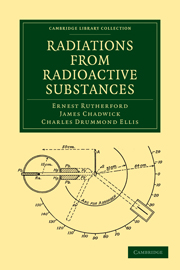Book contents
- Frontmatter
- Contents
- LIST OF PLATES
- Preface
- Chap. I Radioactive Transformations
- Chap. II The α Rays
- Chap. III Absorption of the α Rays
- Chap. IV Some Properties of the α Particle
- Chap. V Theories of Absorption of α Rays
- Chap. VI Secondary Effects produced by α Rays
- Chap. VII General Properties of the Radiations
- Chap. VIII The Scattering of α and β Particles
- Chap. IX The Collisions of α Particles with Light Atoms
- Chap. X The Artificial Disintegration of the Light Elements
- Chap. XI The Radioactive Nuclei
- Chap. XII β Ray and γ Ray Spectra
- Chap. XIII The Disintegration Electrons
- Chap. XIV The Passage of β Particles through Matter
- Chap. XV The Scattering and Absorption of γ Rays
- Chap. XVI Intensity Problems connected with the Emission of γ Rays
- Chap. XVII Atomic Nuclei
- Chap. XVIII Miscellaneous
- Appendix
- Subject Index
- Index of Names
- Plate section
Chap. X - The Artificial Disintegration of the Light Elements
Published online by Cambridge University Press: 07 September 2010
- Frontmatter
- Contents
- LIST OF PLATES
- Preface
- Chap. I Radioactive Transformations
- Chap. II The α Rays
- Chap. III Absorption of the α Rays
- Chap. IV Some Properties of the α Particle
- Chap. V Theories of Absorption of α Rays
- Chap. VI Secondary Effects produced by α Rays
- Chap. VII General Properties of the Radiations
- Chap. VIII The Scattering of α and β Particles
- Chap. IX The Collisions of α Particles with Light Atoms
- Chap. X The Artificial Disintegration of the Light Elements
- Chap. XI The Radioactive Nuclei
- Chap. XII β Ray and γ Ray Spectra
- Chap. XIII The Disintegration Electrons
- Chap. XIV The Passage of β Particles through Matter
- Chap. XV The Scattering and Absorption of γ Rays
- Chap. XVI Intensity Problems connected with the Emission of γ Rays
- Chap. XVII Atomic Nuclei
- Chap. XVIII Miscellaneous
- Appendix
- Subject Index
- Index of Names
- Plate section
Summary
§ 64. The idea of the artificial disintegration or transmutation of an element is one which has persisted since the Middle Ages. In the times of the alchemists the search for the “philosopher's stone,” by the help of which one form of matter could be converted into another, was pursued with confidence and hope under the direct patronage of rulers and princes, who expected in this way to restore their finances and to repay the debts of the state. In spite of this encouragement the successful transmutation of some common matter into gold was but seldom reported. Even in these cases the transmutation could not be repeated; either the alchemist had vanished or his supply of the “philosopher's stone” had been exhausted. The failures were many and the natural disappointment of the patron usually vented itself on the person of the alchemist; the search sometimes ended on a gibbet gilt with tinsel. But when the confidence of the patrons departed the hope of the alchemists still remained, for the idea of transmutation not only accorded with the desires of the man but was founded on the conceptions of the philosopher. According to Aristotle all bodies are formed from a fundamental substance, “primordial matter,” and the four elements—water, earth, air, and fire—differed from each other only by possession of different combinations of the properties of cold, wet, warm, and dry. By changing the properties one element should be changed into another. On this view, it was almost self-evident that bodies so closely allied as the metals could interchange their qualities.
- Type
- Chapter
- Information
- Radiations from Radioactive Substances , pp. 281 - 316Publisher: Cambridge University PressPrint publication year: 2010First published in: 1930

